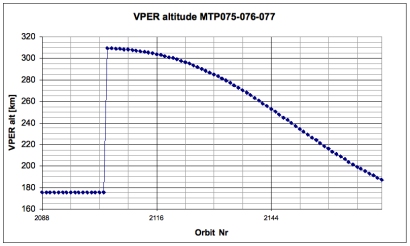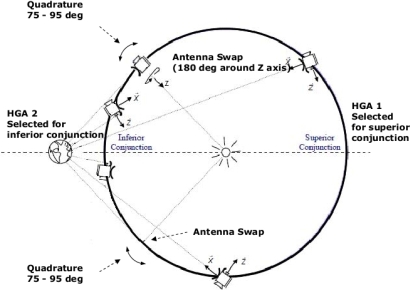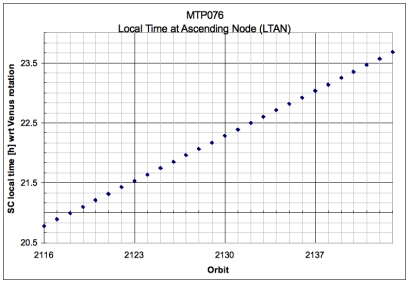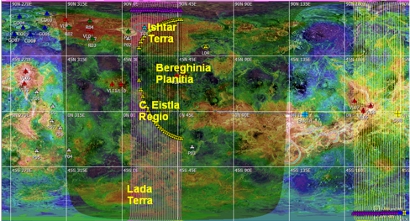No. 244 – Start of the twentieth solar eclipse season and start of quadrature operations
Cebreros ground station
During the Cebreros (CEB) pass on 13 February, a station anomaly affected the servo control system, which assures the highest possible pointing accuracy under the site's environmental conditions, causing de-pointing of the antenna. After several intermittent failures, the station reported that the problem was traced to a faulty circuit breaker in the 24V DC power line to the elevation axis. This was replaced and full performance of the servo was recovered.
This incident affected science data from the magnetometer (MAG), the monitoring camera (VMC) and the imaging spectrometer (VIRTIS). The data were copied on board and downlinked during the following few days, however, 19 packets of MAG data from the period between 15:54 UTC and 16:10 UTC on 13 February could not be recovered.
The CEB passes on 14 and 15 February were shorter than normal due to scheduled ground station maintenance.
High accuracy spacecraft ranging
ESA's CEB and New Norcia (NNO) ground stations were used for a Delta Differential One-way Ranging (delta-DOR, or DDOR) measurement on 22 February.
These measurements are carried out with the Venus Express spacecraft on a regular basis to support the accurate determination of the ephemeris for the planet Venus that is maintained by NASA's Solar System Dynamics Group. The DDOR measurements pinpoint the location of the Venus Express spacecraft; the location of the spacecraft with respect to the planet centre is known to high accuracy. Combining the two allows the orbit of Venus to be determined with very high accuracy. Modern-day DDOR campaigns are carrying on a tradition started by ancient civilizations - the orbit of Venus has been measured throughout the ages, with increasing accuracy; it is increasingly important in the space age.
The DDOR technique uses two widely separated antennas to simultaneously track the location of a transmitter in space in order to measure the time delay between signals arriving at the two stations. Theoretically, the delay depends only on the positions of the two antennas and the spacecraft. In reality, it is affected by several sources of error: for example, the radio waves travelling through the troposphere, ionosphere and solar plasma, and clock instabilities at the ground station. DDOR corrects these errors by ‘tracking' a quasar in a direction close to the spacecraft for calibration. The quasar's direction is already known to very high accuracy by astronomical measurements, typically to better than 50 billionths of a degree (a nanoradian). The quasar is usually within 10 degrees of the spacecraft so that their signal paths through Earth's atmosphere are similar. In principle, the delay time of the quasar is subtracted from that of the spacecraft's to provide the DDOR measurement.
(For more information about DDOR, see the ESA Bulletin article “Delta-DOR – A New Technique for ESA's Deep Space Navigation” - link in right-hand column.)
Orbit control manoeuvres
Two orbit control manoeuvres were performed successfully during this reporting period. The first was a navigation manoeuvre carried out at pericentre on 26 February. Another navigation manoeuvre was executed at the apocentre of 28 February for regular maintenance of the orbit parameters.
 |
|
Change in Venus Express’s pericentre altitude during the period 8 January to 31 March 2012. Credit: ESA |
Spacecraft clocks synchronised
The clock on the Venus Express spacecraft is a simple count-up timer, typical of those used on spacecraft. These clocks save weight and cost but they tend to drift, and must be synchronized – or correlated – with atomic clocks on Earth at regular intervals. One of these regular time correlations was performed on 28 February, after the CEB ground station pass.
Start of quadrature operations
The thermal requirements of Venus Express are such that only two faces can be exposed to the Sun continuously: +X and +Z. To read more on this, follow the link on 'Terminator orbits' (in the right-hand menu).
To prevent overheating, the spacecraft is 'flipped over' during Earth communication periods to avoid illuminating the sensitive –X face.
When the spacecraft is inside the quadrature arc, it is closer to Earth than at other times during the orbit, and its sensitive -X face becomes illuminated during Earth communications. To avoid this and prevent overheating, the spacecraft is ‘flipped over' while it communicates with Earth. Due to this flip-over, the large high-gain antenna (HGA-1) points in the wrong direction. Therefore a second, smaller high gain antenna (HGA2) was added to the spacecraft design; this is located behind the main Earth communication antenna and points in the opposite direction. During the quadrature period, HGA2 takes over from HGA1 for Earth communications.
Venus Express began operating in the inbound quadrature configuration on 2 March. In this phase, the Sun-spacecraft-Earth angle is between 75 and 95 degrees. Two critical activities must take place during this phase, both related to management of solar illumination on normally cold spacecraft faces:
- Biasing of the spacecraft attitude: To avoid exposure of the monitoring camera's (VMC) sensitive components to the Sun, the spacecraft attitude is biased during Earth communications such that the Sun is offset by 10 degrees from +Z towards +Y. This is achieved by uploading a ‘fake Ephemeris', which tricks the spacecraft into registering that it is pointing somewhere else, and results in the desired attitude. This biased attitude must be maintained for the duration of the quadrature phase.
- HGA swap: To avoid illuminating the sensitive -X face during Earth communication, the Venus Express High Gain Antenna (HGA) is swapped, and HGA2 takes over from HGA1, the primary. This operation involves the reconfiguration of on-board software, attitude re-orientation and reconfiguration of the telemetry, tracking and control (TT&C) software. This is normally completed in less than one hour, and is executed out of pass, shortly before the acquisition of signal (AOS) with CEB. The HGA swap (back to HGA-1) occurs during the next 28-day planning cycle (or medium term plan).
 |
|
Venus Express antenna selection during quadrature operation. |
As the cold +Y spacecraft face is constantly illuminated with 10 degrees Sun aspect angle (SAA) during this phase, a special set of thermal constraints was defined for Venus Express. These constraints impose significant limitations on conducting routine science operations. Despite this, science activities continue, although they are somewhat reduced during this phase. The Venus Express Flight Dynamics team and the Venus Science Operations Centre maintain dedicated interfaces during this period to handle the special thermal checks required.
Summary of main activities
The table below shows a chronology of the main spacecraft bus activities in the reporting period:
| Main activities during reporting period | |||
|
MET = Mission elapsed time; DOY = Day of year; EOC = End of Charge; CEB = Cebreros; NNO = New Norcia; ADE = Atmospheric Drag Experiment; DOR = Differential One-way Ranging OCM = Orbit Correction Manoeuvre |
|||
|
MET (Day) |
Date | DOY | Main Activity |
| 2280 | 05-Feb-2012 | 036 | CEB communication pass. |
| 2281 | 06-Feb-2012 | 037 | CEB communication pass. |
| 2282 | 07-Feb-2012 | 038 | CEB communication pass. Start of the twentieth eclipse season. |
| 2283 | 08-Feb-2012 | 039 | CEB communication pass. |
| 2284 | 09-Feb-2012 | 040 | CEB communication pass. |
| 2285 | 10-Feb-2012 | 041 | CEB communication pass. |
| 2286 | 11-Feb-2012 | 042 | CEB communication pass. |
| 2287 | 12-Feb-2012 | 043 | CEB communication pass. |
| 2288 | 13-Feb-2012 | 044 | CEB communication pass. |
| 2289 | 14-Feb-2012 | 045 | Shortened CEB pass due to scheduled ground station maintenance. Downlink telemetry rate increased to 228 Kbps. |
| 2290 | 15-Feb-2012 | 046 | Shortened CEB pass due to scheduled ground station maintenance. |
| 2291 | 16-Feb-2012 | 047 | CEB communication pass. |
| 2292 | 17-Feb-2012 | 048 | CEB communication pass. |
| 2293 | 18-Feb-2012 | 049 | CEB communication pass. |
| 2294 | 19-Feb-2012 | 050 | CEB communication pass. |
| 2295 | 20-Feb-2012 | 051 | CEB communication pass. |
| 2296 | 21-Feb-2012 | 052 | CEB communication pass. |
| 2297 | 22-Feb-2012 | 053 | CEB communication pass. Delta-DOR performed with NNO support. |
| 2298 | 23-Feb-2012 | 054 | CEB communication pass. |
| 2299 | 24-Feb-2012 | 055 | CEB communication pass. |
| 2300 | 25-Feb-2012 | 056 | CEB communication pass. |
| 2301 | 26-Feb-2012 | 057 | CEB communication pass. |
| 2302 | 27-Feb-2012 | 058 | CEB communication pass. |
| 2303 | 28-Feb-2012 | 059 | CEB communication pass. |
| 2304 | 29-Feb-2012 | 060 | CEB communication pass. |
| 2305 | 01-Mar-2012 | 061 | CEB communication pass. |
| 2306 | 02-Mar-2012 | 062 | CEB communication pass. |
| 2307 | 03-Mar-2012 | 063 | CEB communication pass. |
At the end of the reporting period on 3 March, Venus Express was at 132.64 million km from Earth. The one-way signal travel time was 442 seconds.
The final oxidizer mass was 28.388 kg and the final fuel mass was 17.608 kg.
Scientific focus
The status reports will henceforth include a scientific overview of operations carried out during each medium term plan (MTP), a four-week period made up of 28 days, consisting of four seven-day periods. The current report falls under MTP 76, 5 February to 3 March 2012.
 |
|
Change in Venus Express’s local time at ascending node. Credit: ESA |
The twentieth eclipse season began on 8 February. The Local Time at Ascending Node (LTAN) ranged from 20:40 hours at the start to 23:40 hours. Many observations are performed when the spacecraft is in nadir pointing mode (pointing towards the surface of the planet directly below the spacecraft). The angle of the Sun on the planet's surface is therefore the same as the angle of the Sun on the spacecraft. This Sun angle means that this was a cold period: a nadir observation did not illuminate any of the thermally restricted faces on the spacecraft, allowing long, unrestricted nadir observations.
 |
|
Planet coverage during medium term plan (MTP) 76. Credit: ESA |
During MTP 76, science targets included: Ishtar Terra in the Northern Hemisphere and Central Eistla Regio, which has been identified as a ‘hotspot' — a surface manifestation of a mantle upwelling. The area observed in the Southern hemisphere hosts ground features that have been observed in the past by the imaging spectrometer (VIRTIS) and which are of interest to look at again.
Venus Express flew over Bereghinia Planitia on 18 February during an eclipse. Situated at 28°E, 39°N, this area was identified as the location of a possible cooling lava flow by Bondarenko et al (GRL, 2009), using the atmospheric spectrometer (SPICAV infrared nadir observations) as well as the monitoring camera (VMC).
Payload activities
The instruments were operated nominally as per the plans of each instrument team.
| ASPERA |
The instrument was operated nominally. On 2 March, the day of quadrature entry, a low temperature alarm, at -28 °C, was triggered on the ASPERA data processing unit. This happened during the first activation of ASPERA just before the end of the tilted Cebreros Earth communications pass. The temperature returned to within the nominal range in an hour. This is a recurrence of a previously seen anomaly, and the instrument team decided that no action was required. |
| MAG | Nineteen packets of magnetometer (MAG) data were lost and were not recoverable due to the problem with the CEB servo system, which caused the antenna to depoint. |
| PFS | The instrument was not operated. |
| SPICAV | The instrument was operated nominally. |
| VMC | Eight VMC commands failed to execute on 23 February between 07:09 UTC and 07:13 UTC. This is a regular reoccurrence of a known anomaly. |
| VeRa | The instrument was not operated. |
| VIRTIS |
The instrument was operated nominally. Three alarms were triggered when VIRTIS registered that the CCD temperature reached -51 °C on 29 February. This is a re-occurrence of a previous anomaly, which is usual on quadrature entry due to the spacecraft attitude. No action was required. |
Future milestones
- Continuation of the twentieth solar eclipse season
- Start of the thirteenth Earth occultation season
- Switch from High Gain Antenna 2 to High Gain Antenna 1
- Exit quadrature season and the required tilted attitude for Earth communications
- Start of the eighth Atmospheric Drag Experiment campaign
---
Legal disclaimer
This report is based on four ESOC mission operations reports, MOR #324 through MOR #327, as well as the MTP076 Master Science Report. Please see the copyright section of the legal disclaimer (bottom of this page) for terms of use.
